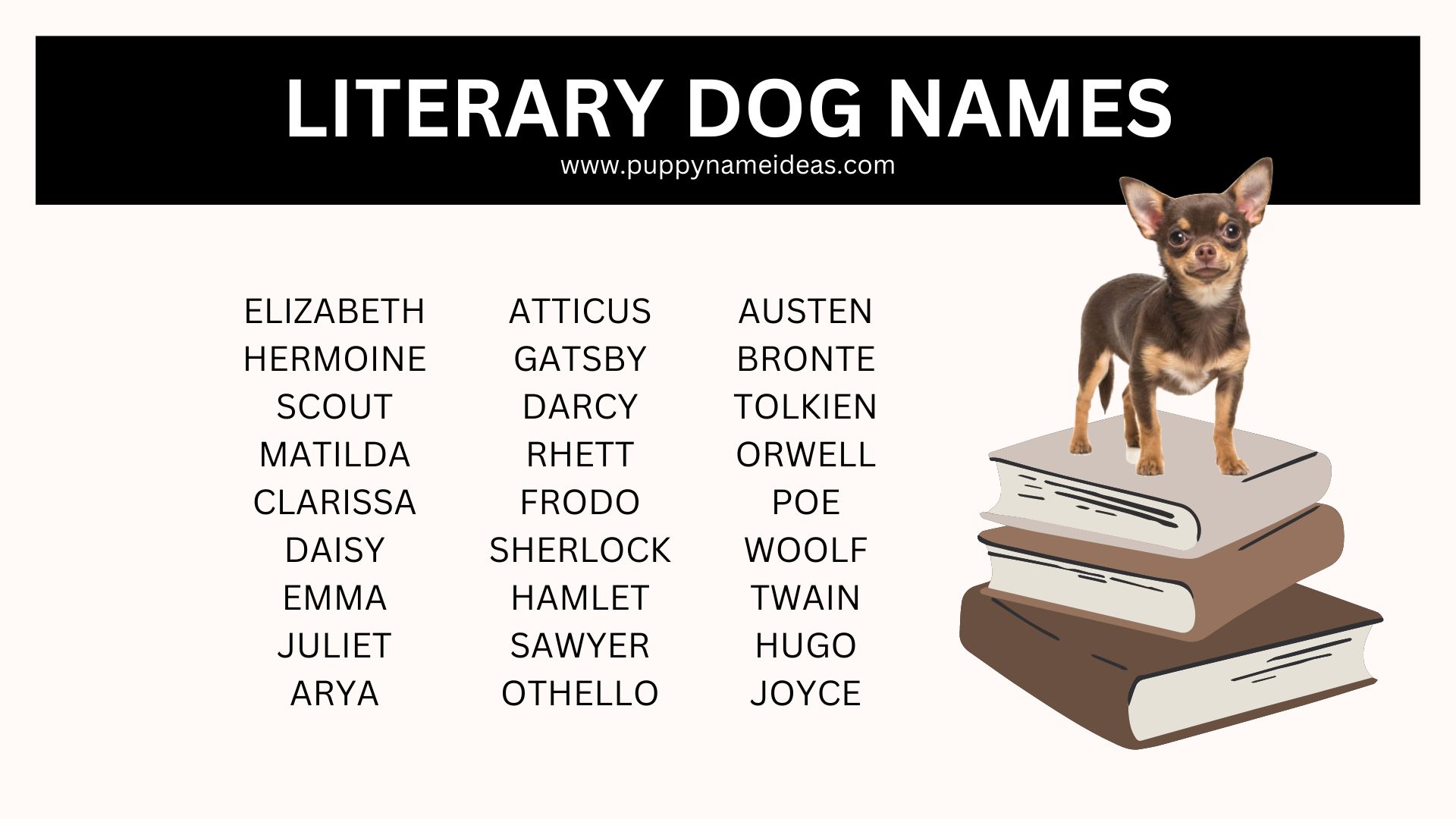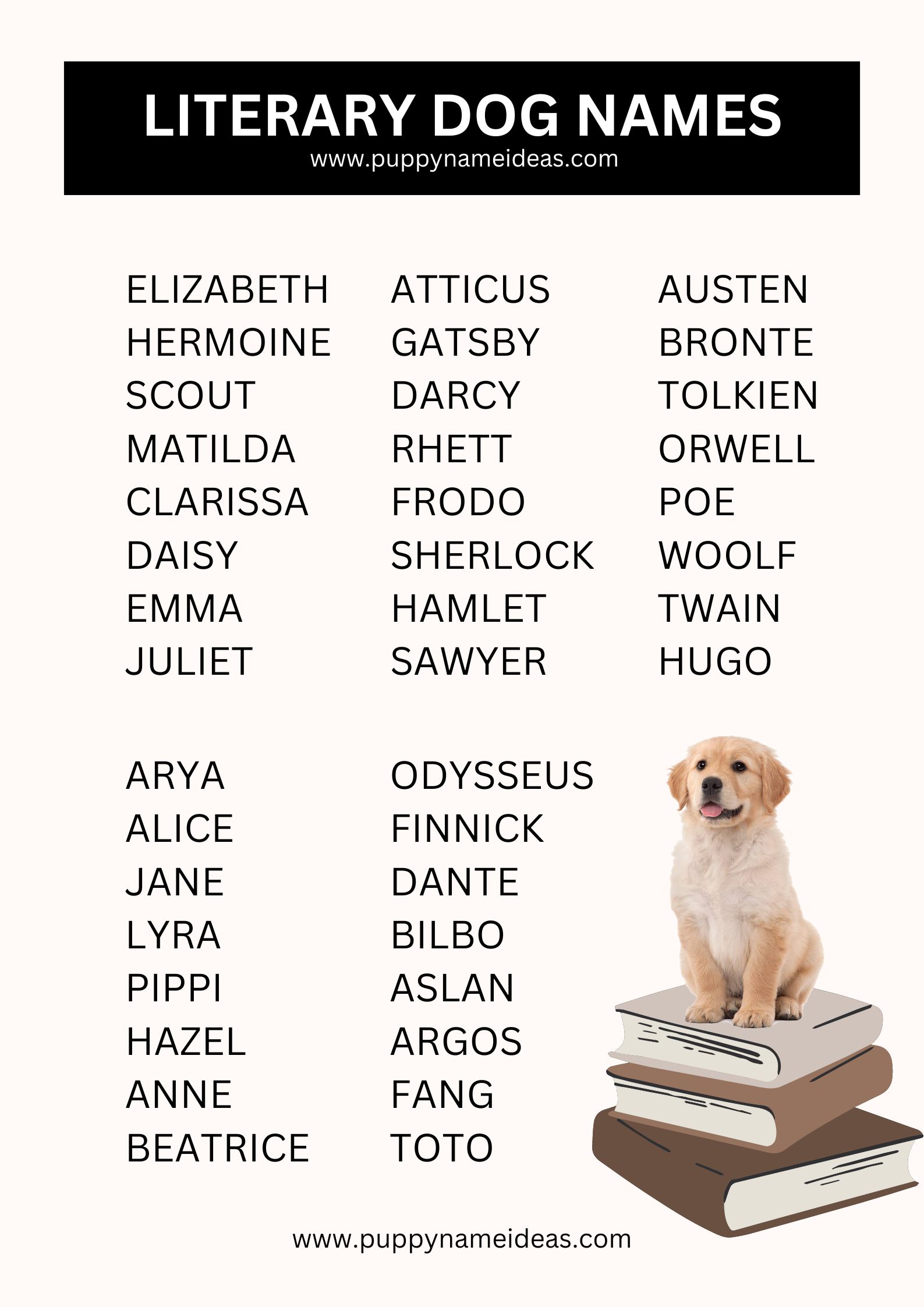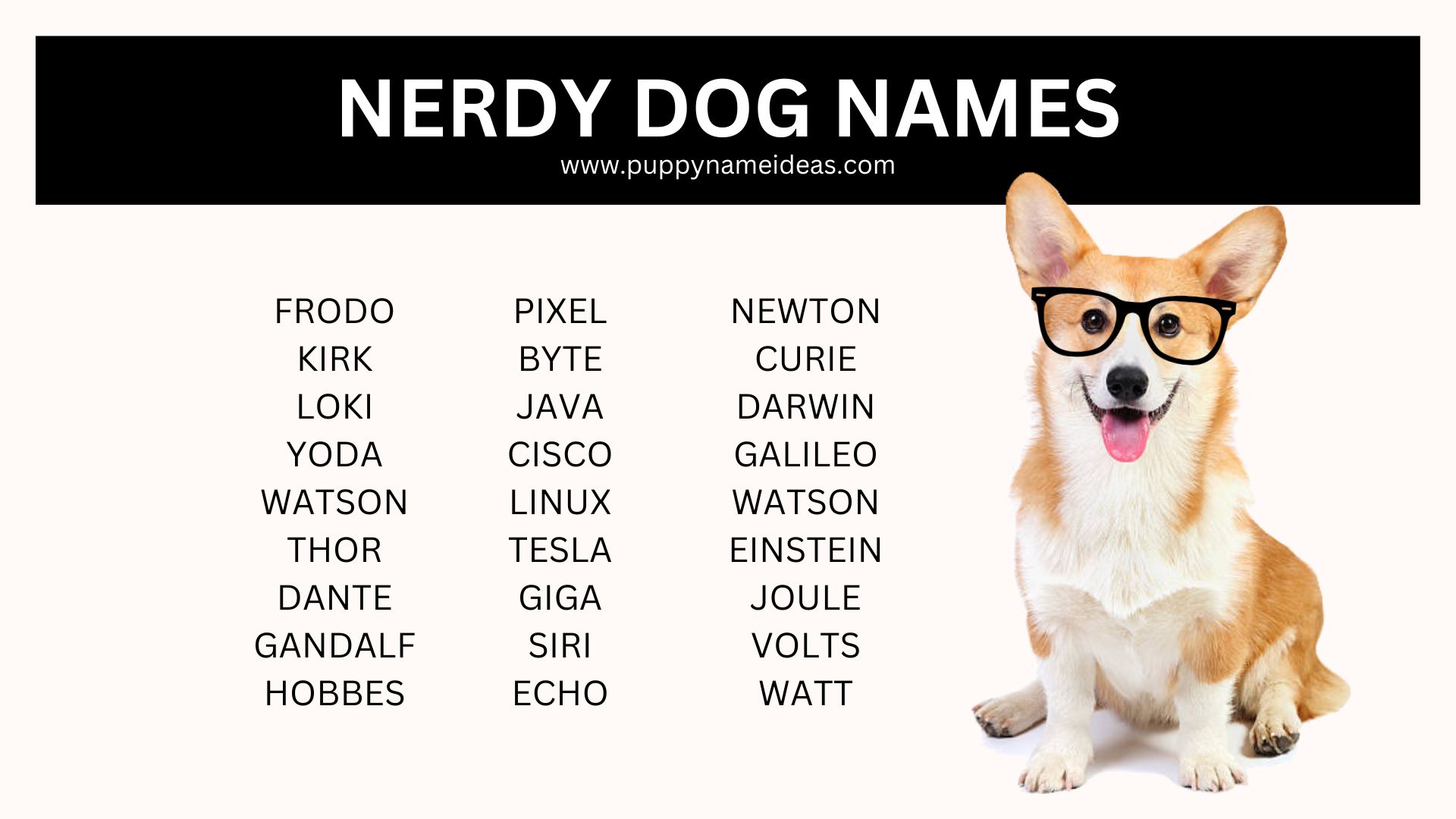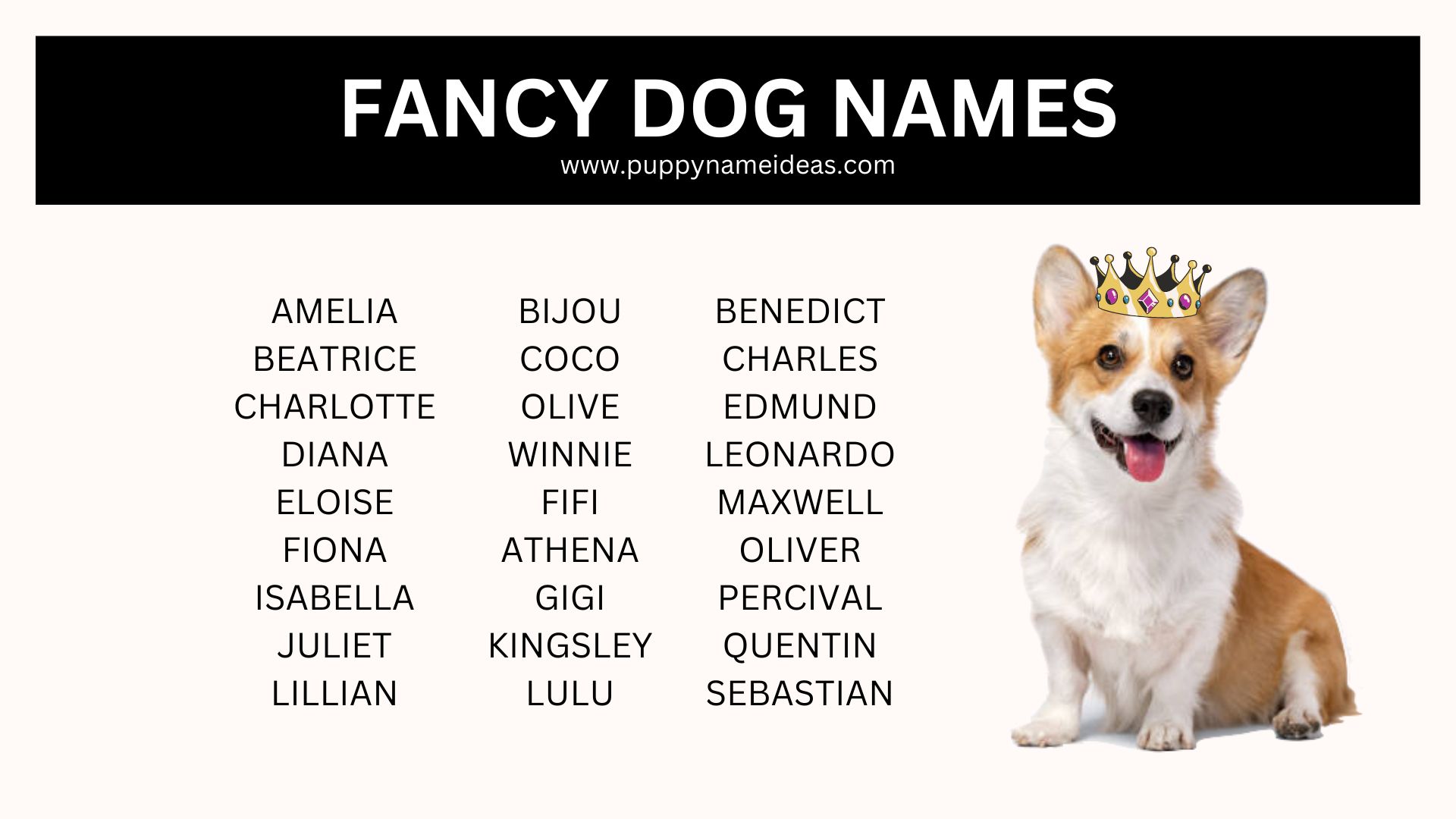180+ Literary Dog Names

Choosing a name for your new furry friend can be a delightful process, especially for literature enthusiasts. Literary dog names not only carry a sense of nostalgia and depth but also celebrate the rich worlds and characters created by generations of storytellers. Whether you’re inspired by female or male characters, authors themselves, or the fantastical worlds they’ve created, there’s a literary name out there that perfectly matches your dog’s personality, appearance, or the whimsy you hope to capture. Here’s a curated list of literary dog names to inspire your choice.
Female Literary Dog Names
- Elizabeth – After Elizabeth Bennet, the witty and spirited protagonist of Jane Austen’s “Pride and Prejudice.”
- Hermione – Named for the brilliant and brave Hermione Granger from J.K. Rowling’s “Harry Potter” series.
- Scout – Inspired by Scout Finch, the curious and fearless narrator of Harper Lee’s “To Kill a Mockingbird.”
- Matilda – After Matilda Wormwood, the young, gifted heroine of Roald Dahl’s “Matilda.”
- Jo – Named for Jo March, the independent and fiery sister in Louisa May Alcott’s “Little Women.”
- Clarissa – After Clarissa Dalloway, the complex and reflective protagonist of Virginia Woolf’s “Mrs. Dalloway.”
- Daisy – Inspired by Daisy Buchanan, the enigmatic and tragic figure in F. Scott Fitzgerald’s “The Great Gatsby.”
- Emma – After Emma Woodhouse, the clever and somewhat misguided matchmaker in Jane Austen’s “Emma.”
- Juliet – Named for the passionate and doomed Juliet Capulet of William Shakespeare’s “Romeo and Juliet.”
- Meg – Inspired by Meg Murry, the courageous and loving protagonist of Madeleine L’Engle’s “A Wrinkle in Time.”
- Arya – After Arya Stark, the resilient and fierce warrior from George R.R. Martin’s “A Song of Ice and Fire.”
- Alice – Named for Alice, the curious explorer of Lewis Carroll’s “Alice’s Adventures in Wonderland.”
- Jane – After Jane Eyre, the determined and moral protagonist of Charlotte Brontë’s “Jane Eyre.”
- Lyra – Inspired by Lyra Belacqua, the adventurous and bold heroine of Philip Pullman’s “His Dark Materials.”
- Pippi – After Pippi Longstocking, the strong and spirited girl in Astrid Lindgren’s series.
- Hazel – Named for Hazel Lancaster, the thoughtful and resilient protagonist of John Green’s “The Fault in Our Stars.”
- Catherine – After Catherine Earnshaw, the passionate and willful character in Emily Brontë’s “Wuthering Heights.”
- Galadriel – Inspired by Galadriel, the powerful and wise elf queen in J.R.R. Tolkien’s “The Lord of the Rings.”
- Bella – Named for Bella Swan, the relatable and love-struck protagonist of Stephenie Meyer’s “Twilight” saga.
- Anne – After Anne Shirley, the imaginative and talkative orphan in L.M. Montgomery’s “Anne of Green Gables.”
- Scarlett – Inspired by Scarlett O’Hara, the determined and complex heroine of Margaret Mitchell’s “Gone with the Wind.”
- Beatrice – After Beatrice, the witty and spirited character in William Shakespeare’s “Much Ado About Nothing.”
- Luna – Named for Luna Lovegood, the quirky and loyal friend in J.K. Rowling’s “Harry Potter” series.
- Nancy – After Nancy Drew, the intelligent and daring detective in the series by Carolyn Keene.
- Ramona – Inspired by Ramona Quimby, the spunky and adventurous young girl in Beverly Cleary’s series.
- Tess – After Tess Durbeyfield, the tragic and resilient protagonist of Thomas Hardy’s “Tess of the D’Urbervilles.”
- Clarice – Named for Clarice Starling, the intelligent and determined FBI trainee in Thomas Harris’s “The Silence of the Lambs.”
- Eowyn – Inspired by Eowyn, the brave and noble warrior in J.R.R. Tolkien’s “The Lord of the Rings.”
- Marianne – After Marianne Dashwood, the emotional and romantic sister in Jane Austen’s “Sense and Sensibility.”
- Sylvia – Named for Sylvia Plath, the profound and introspective poet and author of “The Bell Jar.”
Read Also: French Dog Names
Male Literary Dog Names
- Atticus – After Atticus Finch, the wise and moral father in Harper Lee’s “To Kill a Mockingbird.”
- Holden – Named for Holden Caulfield, the disillusioned and critical narrator of J.D. Salinger’s “The Catcher in the Rye.”
- Gatsby – Inspired by Jay Gatsby, the mysterious and hopeful protagonist of F. Scott Fitzgerald’s “The Great Gatsby.”
- Darcy – After Fitzwilliam Darcy, the proud yet noble gentleman in Jane Austen’s “Pride and Prejudice.”
- Rhett – Named for Rhett Butler, the charismatic and complex love interest in Margaret Mitchell’s “Gone with the Wind.”
- Heathcliff – Inspired by Heathcliff, the passionate and tormented protagonist of Emily Brontë’s “Wuthering Heights.”
- Orlando – After Orlando, the adventurous and ever-changing protagonist of Virginia Woolf’s “Orlando.”
- Frodo – Named for Frodo Baggins, the brave and resilient hobbit in J.R.R. Tolkien’s “The Lord of the Rings.”
- Sherlock – Inspired by Sherlock Holmes, the brilliant and deductive detective in Sir Arthur Conan Doyle’s stories.
- Hamlet – After Hamlet, the contemplative and troubled prince in William Shakespeare’s “Hamlet.”
- Sawyer – Named for Tom Sawyer, the adventurous and mischievous boy in Mark Twain’s “The Adventures of Tom Sawyer.”
- Winston – Inspired by Winston Smith, the rebellious and thoughtful protagonist of George Orwell’s “1984.”
- Huck – After Huckleberry Finn, the independent and moral character in Mark Twain’s “Adventures of Huckleberry Finn.”
- Gandalf – Named for Gandalf, the wise and powerful wizard in J.R.R. Tolkien’s “The Lord of the Rings.”
- Lennie – Inspired by Lennie Small, the gentle and tragic figure in John Steinbeck’s “Of Mice and Men.”
- Rochester – After Edward Rochester, the brooding and complex master in Charlotte Brontë’s “Jane Eyre.”
- Pip – Named for Pip, the ambitious and evolving protagonist in Charles Dickens’s “Great Expectations.”
- Odysseus – Inspired by Odysseus, the cunning and resilient hero of Homer’s “The Odyssey.”
- Finnick – After Finnick Odair, the charismatic and skilled tribute in Suzanne Collins’s “The Hunger Games.”
- Aslan – Named for Aslan, the noble and powerful lion in C.S. Lewis’s “The Chronicles of Narnia.”
- Dante – Inspired by Dante Alighieri, the poet and pilgrim of his own “Divine Comedy.”
- Ahab – After Captain Ahab, the obsessed and vengeful sea captain in Herman Melville’s “Moby-Dick.”
- Jekyll – Named for Dr. Henry Jekyll, the conflicted scientist in Robert Louis Stevenson’s “Strange Case of Dr Jekyll and Mr Hyde.”
- Bilbo – Inspired by Bilbo Baggins, the adventurous and clever hobbit in J.R.R. Tolkien’s “The Hobbit.”
- Algernon – After Algernon Moncrieff, the witty and playful character in Oscar Wilde’s “The Importance of Being Earnest.”
- Beowulf – Named for Beowulf, the heroic and mighty warrior in the epic poem “Beowulf.”
- Quixote – Inspired by Don Quixote, the idealistic and adventurous knight from Miguel de Cervantes’s novel.
- Valjean – After Jean Valjean, the compassionate and redeemed convict in Victor Hugo’s “Les Misérables.”
- Archer – Named for Newland Archer, the introspective and conflicted protagonist of Edith Wharton’s “The Age of Innocence.”
- Merlin – Inspired by Merlin, the legendary and wise wizard in Arthurian legend.
Read Also: Dog Names from Movies
Dogs from Literature
- Argos – After Odysseus’s loyal dog in Homer’s “The Odyssey,” known for his unwavering faithfulness.
- Buck – Named for Buck, the sturdy and adventurous dog in Jack London’s “The Call of the Wild.”
- Fang – Inspired by Hagrid’s loyal and massive boarhound in J.K. Rowling’s “Harry Potter” series.
- Garm – After Garm, the faithful dog in Rudyard Kipling’s “The Jungle Book,” known for his protective nature.
- Jip – Named for Jip, the intelligent and loyal dog in Charles Dickens’s “David Copperfield.”
- Lad – Inspired by Lad, the courageous and noble collie in Albert Payson Terhune’s “Lad: A Dog.”
- Nana – After Nana, the caring and responsible Newfoundland in J.M. Barrie’s “Peter Pan.”
- Old Dan – Named for Old Dan, one of the inseparable coonhound duo in Wilson Rawls’s “Where the Red Fern Grows.”
- Pilot – Inspired by Pilot, Mr. Rochester’s faithful and protective dog in Charlotte Brontë’s “Jane Eyre.”
- Rip – After Rip, the streetwise and loyal dog in Charles Dickens’s “Oliver Twist.”
- Shiloh – Named for Shiloh, the beagle who wins the heart of a young boy in Phyllis Reynolds Naylor’s “Shiloh.”
- Snoopy – Inspired by Snoopy, the imaginative and iconic beagle in Charles M. Schulz’s “Peanuts” comic strip.
- Tock – After Tock, the watchdog with a literal watch in his side in Norton Juster’s “The Phantom Tollbooth.”
- Toto – Named for Toto, Dorothy’s small but brave dog in L. Frank Baum’s “The Wonderful Wizard of Oz.”
- White Fang – Inspired by White Fang, the fierce and resilient wolf-dog in Jack London’s “White Fang.”
- Yeller – After Old Yeller, the loyal and protective dog in Fred Gipson’s “Old Yeller.”
- Marley – Named for Marley, the lovable and mischievous Labrador retriever in John Grogan’s “Marley & Me.”
- Flush – Inspired by Flush, Elizabeth Barrett Browning’s beloved cocker spaniel, as depicted in Virginia Woolf’s “Flush: A Biography.”
- Napoleon – After Napoleon, the farm’s tyrannical leader in George Orwell’s “Animal Farm,” though not a dog, represents a powerful name.
- Timmy – Named for Timmy, the adventurous and faithful dog in Enid Blyton’s “The Famous Five” series.
- Laska – Inspired by Laska, Levin’s intelligent and sensitive hunting dog in Leo Tolstoy’s “Anna Karenina.”
- Pongo – After Pongo, the dashing and daring Dalmatian in Dodie Smith’s “The Hundred and One Dalmatians.”
- Cujo – Named for Cujo, the once-gentle Saint Bernard turned terrifying in Stephen King’s “Cujo.”
- Krypto – Inspired by Krypto, the Superdog, friend and companion to Superman in the DC Comics universe.
- Blue – After Blue, the dependable dog in Phyllis Reynolds Naylor’s “Blue’s Story.”
- Skip – Named for Skip, the loyal and spirited Jack Russell Terrier in Willie Morris’s “My Dog Skip.”
- Milo – Inspired by Milo, the supportive and adventurous dog in “The Adventures of Milo and Otis.”
- Wellington – After Wellington, the unfortunate dog whose mystery kicks off Mark Haddon’s “The Curious Incident of the Dog in the Night-Time.”
- Shadow – Named for Shadow, the wise and faithful Golden Retriever in “Homeward Bound: The Incredible Journey.”
Read Also: Famous Dog Names
Dog Names Inspired by Authors
- Austen – After Jane Austen, the esteemed novelist known for her keen observations on society and love.
- Brontë – Named for the Brontë sisters, Charlotte, Emily, and Anne, celebrated for their powerful and pioneering works.
- Tolkien – Inspired by J.R.R. Tolkien, the father of modern fantasy literature and creator of Middle-earth.
- Hemingway – After Ernest Hemingway, the Nobel Prize-winning author known for his concise and impactful prose.
- Fitzgerald – Named for F. Scott Fitzgerald, who captured the spirit of the Jazz Age in his writings.
- Orwell – Inspired by George Orwell, renowned for his insightful social commentary and novels like “1984” and “Animal Farm.”
- Shakespeare – After William Shakespeare, the Bard of Avon, whose plays and sonnets are timeless.
- Dickens – Named for Charles Dickens, celebrated for his vivid characters and critiques of Victorian society.
- Poe – Inspired by Edgar Allan Poe, the master of macabre and inventor of detective fiction.
- Woolf – After Virginia Woolf, a pioneering modernist author known for her stream-of-consciousness technique.
- Twain – Named for Mark Twain, the great American humorist and author of “The Adventures of Tom Sawyer.”
- Austen – After Jane Austen, renowned for her novels of manners, including “Pride and Prejudice.”
- Hawthorne – Named for Nathaniel Hawthorne, known for his dark romanticism and works like “The Scarlet Letter.”
- Kafka – Inspired by Franz Kafka, whose surreal and existential works have left a profound impact on literature.
- Dostoevsky – After Fyodor Dostoevsky, the Russian novelist known for his psychological depth and exploration of morality.
- Hugo – Named for Victor Hugo, the French poet, novelist, and dramatist of the Romantic movement.
- Whitman – Inspired by Walt Whitman, the American poet and humanist famous for “Leaves of Grass.”
- Joyce – After James Joyce, a key figure in modernist literature known for “Ulysses” and its stream-of-consciousness style.
- Plath – Named for Sylvia Plath, the talented and troubled poet known for “The Bell Jar” and her confessional poetry.
- Kerouac – Inspired by Jack Kerouac, a pioneer of the Beat Generation and author of “On the Road.”
- Angelou – After Maya Angelou, the American poet, memoirist, and civil rights activist known for “I Know Why the Caged Bird Sings.”
- Hesse – Named for Hermann Hesse, the German-born Swiss poet, novelist, and painter, known for “Steppenwolf.”
- Neruda – Inspired by Pablo Neruda, the Chilean poet and Nobel Prize winner known for his passionate love poems.
- Eliot – After T.S. Eliot, the modernist poet and critic known for “The Waste Land.”
- Wilde – Named for Oscar Wilde, the Irish playwright, poet, and author known for his wit and criticism of Victorian society.
- Rushdie – Inspired by Salman Rushdie, the British Indian novelist and essayist known for “Midnight’s Children.”
- Marquez – After Gabriel García Márquez, the Colombian novelist and Nobel laureate known for his magical realism.
- Chekhov – Named for Anton Chekhov, the Russian playwright and master of the modern short story.
- Morrison – Inspired by Toni Morrison, the American novelist and Nobel laureate known for “Beloved.”
- Faulkner – After William Faulkner, the American writer and Nobel Prize laureate known for his complex narratives and innovative techniques.
- Vonnegut – Named for Kurt Vonnegut, the American writer known for his satirical and science-fiction works.
- Coelho – Inspired by Paulo Coelho, the Brazilian lyricist and novelist, best known for “The Alchemist.”
Read Also: Disney Dog Names
Dog Names Inspired by Literary Characters
- Gulliver – After Lemuel Gulliver, the explorer and narrator of Jonathan Swift’s “Gulliver’s Travels.”
- Phileas – Named for Phileas Fogg, the adventurous and precise protagonist of Jules Verne’s “Around the World in Eighty Days.”
- Dorian – Inspired by Dorian Gray, the eternally youthful and morally ambiguous character in Oscar Wilde’s “The Picture of Dorian Gray.”
- Cosette – After Cosette, the innocent and loving ward in Victor Hugo’s “Les Misérables.”
- Raskolnikov – Named for Rodion Raskolnikov, the complex and conflicted protagonist of Fyodor Dostoevsky’s “Crime and Punishment.”
- Desdemona – Inspired by Desdemona, the virtuous and tragic heroine in William Shakespeare’s “Othello.”
- Ishmael – After Ishmael, the philosophical and observant narrator of Herman Melville’s “Moby-Dick.”
- Porthos – Named for Porthos, the strong and loyal musketeer in Alexandre Dumas’s “The Three Musketeers.”
- Estella – Inspired by Estella Havisham, the beautiful and haughty love interest in Charles Dickens’s “Great Expectations.”
- Heidi – After Heidi, the cheerful and optimistic orphan in Johanna Spyri’s novel “Heidi.”
- Pip – Named for Philip Pirrip, the ambitious and kind-hearted protagonist of Charles Dickens’s “Great Expectations.”
- Scarlett – Inspired by Scarlett O’Hara, the determined and complex heroine of Margaret Mitchell’s “Gone with the Wind.”
- Gandalf – After Gandalf, the wise and powerful wizard in J.R.R. Tolkien’s “The Lord of the Rings.”
- Lolita – Named for Lolita, the young and controversial character in Vladimir Nabokov’s novel “Lolita.”
- Rochester – Inspired by Edward Rochester, the brooding and complex master in Charlotte Brontë’s “Jane Eyre.”
- Becky – After Becky Sharp, the ambitious and cunning protagonist of William Makepeace Thackeray’s “Vanity Fair.”
- Gatsby – Named for Jay Gatsby, the enigmatic and hopeful protagonist of F. Scott Fitzgerald’s “The Great Gatsby.”
- Emma – Inspired by Emma Woodhouse, the clever and somewhat misguided matchmaker in Jane Austen’s “Emma.”
- Santiago – After Santiago, the old and determined fisherman in Ernest Hemingway’s “The Old Man and the Sea.”
- Hester – Named for Hester Prynne, the resilient and stigmatized protagonist of Nathaniel Hawthorne’s “The Scarlet Letter.”
- Jean Valjean – Inspired by Jean Valjean, the compassionate and redeemed convict in Victor Hugo’s “Les Misérables.”
- Darcy – After Fitzwilliam Darcy, the proud yet noble gentleman in Jane Austen’s “Pride and Prejudice.”
- Ahab – Named for Captain Ahab, the obsessed and vengeful sea captain in Herman Melville’s “Moby-Dick.”
- Bilbo – Inspired by Bilbo Baggins, the adventurous and clever hobbit in J.R.R. Tolkien’s “The Hobbit.”
- Celie – After Celie, the resilient and evolving protagonist of Alice Walker’s “The Color Purple.”
- Holden – Named for Holden Caulfield, the disillusioned and critical narrator of J.D. Salinger’s “The Catcher in the Rye.”
- Sherlock – Inspired by Sherlock Holmes, the brilliant and deductive detective in Sir Arthur Conan Doyle’s stories.
- Jane – After Jane Eyre, the determined and moral protagonist of Charlotte Brontë’s “Jane Eyre.”
- Atticus – Named for Atticus Finch, the wise and moral father in Harper Lee’s “To Kill a Mockingbird.”
- Huck – Inspired by Huckleberry Finn, the independent and moral character in Mark Twain’s “Adventures of Huckleberry Finn.”
Read Also: Nature Dog Names
Dog Names Inspired by Literary Worlds
- Narnia – After the magical and mysterious land in C.S. Lewis’s “The Chronicles of Narnia.”
- Westeros – Named for the complex and war-torn continent in George R.R. Martin’s “A Song of Ice and Fire.”
- Neverland – Inspired by the island of eternal childhood in J.M. Barrie’s “Peter Pan.”
- Hogwarts – After the famed wizarding school in J.K. Rowling’s “Harry Potter” series.
- Oz – Named for the magical land over the rainbow in L. Frank Baum’s “The Wonderful Wizard of Oz.”
- Pemberley – Inspired by the grand estate of Mr. Darcy in Jane Austen’s “Pride and Prejudice.”
- Shire – After the peaceful and idyllic homeland of the hobbits in J.R.R. Tolkien’s “The Lord of the Rings.”
- 221B – Inspired by the iconic address of Sherlock Holmes in Sir Arthur Conan Doyle’s detective stories.
- Avonlea – After the quaint and picturesque village in L.M. Montgomery’s “Anne of Green Gables.”
- Camelot – Named for the legendary castle and court associated with King Arthur.
- Utopia – Inspired by the ideal society in Thomas More’s work of the same name.
- Inkworld – After the magical realm in Cornelia Funke’s “Inkheart” series.
- Elendel – Named for the bustling capital city in Brandon Sanderson’s “Mistborn” series.
- Pandora – Inspired by the vibrant and dangerous planet in James Cameron’s “Avatar,” known for its deep connection to many forms of literature and myth.
- Emerald – Named after “Emerald City” the capital city of Oz, full of wonders and ruled by the Wizard, in L. Frank Baum’s “The Wonderful Wizard of Oz.”
- Arrakis – Inspired by the desert planet, also known as Dune, in Frank Herbert’s “Dune” series.
- Rivendell – After the Elven refuge in the middle of Middle-earth, known for its beauty and wisdom in J.R.R. Tolkien’s “The Lord of the Rings.”
- Gilead – Named for the theocratic regime in Margaret Atwood’s “The Handmaid’s Tale.”
- Atlantis – Inspired by the mythical island nation first mentioned by Plato, often depicted as an advanced utopian society.
- Discworld – After Terry Pratchett’s fantastical world, characterized by its flat, disc shape balanced on the backs of four elephants.
- Wonderland – Named for the surreal and bizarre world Alice visits in Lewis Carroll’s “Alice’s Adventures in Wonderland.”
- Lilliput – Inspired by the island nation inhabited by small people in Jonathan Swift’s “Gulliver’s Travels.”
- Panem – After the dystopian country in Suzanne Collins’s “The Hunger Games” trilogy.
- Xanadu – Named for the magnificent, idyllic place described in Samuel Taylor Coleridge’s poem “Kubla Khan.”
- Thedas – Inspired by the continent and setting of the “Dragon Age” video game series, rich in lore and history.
- Asgard – After the realm of the gods in Norse mythology, popularized in literature and adaptations like those in Marvel Comics.
- Zion – Named for the last human city in the “Matrix” series, symbolizing a beacon of hope.
- Hades – Inspired by the ancient Greek underworld, often explored in mythology and literature for its mysteries and ruler, Hades.
- Terabithia – After the magical kingdom created by two young friends in Katherine Paterson’s “Bridge to Terabithia.”
Further Reading


